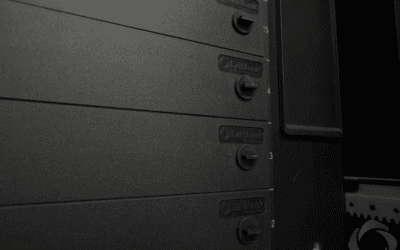In data centers, efficient cooling is crucial to ensure that servers and networking equipment operate effectively without overheating. Servers produce a lot of heat while running, and if this heat is not controlled properly, it can lead to serious problems and even cause servers to fail. One of the simplest yet most effective tools for keeping server racks cool is the use of blanking panels. These panels help to manage airflow and improve cooling system performance, which saves both energy and money. Here we’ll explore how airflow works in server racks and how blanking panels can help make cooling systems more effective.
Understanding Airflow in Server Racks
Server racks are large cabinets that hold a lot of hardware, which can generate a lot of heat when in use. To keep the servers functioning properly, it is important to ensure efficient cooling so they do not overheat or shut down. Cooling works by directing cool air to the right areas and pushing hot air away from the servers. The most common way to do this is by using a “hot aisle/cold aisle” arrangement. In this setup, cold air is pushed through the front of the racks to cool the servers, and hot air is expelled through the back.
Without good airflow management, hot and cold air can mix together inside the server racks. When this happens, the cooling system becomes less efficient, and it can create “hot spots” where heat builds up. These hot spots can cause servers to overheat and become damaged, leading to expensive repairs and even unplanned downtime. Blanking panels help prevent this problem by controlling where the air flows, making sure that cold air reaches the right places and hot air is kept away. They are a simple yet crucial solution to keep the data center environment stable.
How Blanking Panels Help With Airflow in Server Racks
Blanking panels, also called filler panels, are installed in the empty slots in server racks to prevent air from flowing in unintended directions. While blanking panels may seem simple, they have a big impact on how air moves through server racks and how well the cooling system works. Here’s how they help:
1. Preventing Hot Air Recirculation in Server Rack
When there are empty spaces in a server rack, the hot air that is expelled from the back can find its way back to the front of the rack. If this happens, instead of servers receiving fresh cold air, they end up receiving hot air, which makes cooling much less effective. This causes servers to run hotter than they should, which can lead to reduced performance or even failure. Blanking panels fill in these empty spaces, preventing hot air from circulating back to the front and ensuring that servers receive only the cold air they need.
By stopping hot air from recirculating, blanking panels help keep temperatures stable, which prevents servers from overheating or throttling performance. This also ensures that the temperature across all servers remains even, reducing the risk of any single part of the rack getting too hot. When servers are kept at a stable temperature, they can work at their best without the need for constant adjustments to fan speeds or other cooling measures, leading to greater efficiency.
Hot air recirculation can also cause cascading problems in data centers. For example, when one server overheats, it may lead to adjacent servers also struggling to cool down, creating a chain reaction of rising temperatures. Blanking panels stop this from happening by creating a clear separation between the hot and cold air, preventing the spread of heat to nearby equipment.
2. Reducing Bypass Airflow in Server Rack
Another common problem in server racks is bypass airflow. This occurs when cold air takes the easiest path through gaps rather than flowing directly into the servers that need cooling. When cold air escapes through these gaps, it does not effectively cool the servers, which means the cooling system has to work harder to maintain the desired temperature. By installing blanking panels in these gaps, data centers can ensure that cold air goes where it is needed, improving the effectiveness of the cooling system.
Reducing bypass airflow also helps data center operators get the most out of their cooling systems. By ensuring that cold air is directed properly, cooling units can operate more efficiently and use less energy. This leads to lower energy bills and a more balanced cooling load across the entire data center. When cooling systems work more effectively, they also have a longer lifespan because they are not being overworked. By decreasing bypass airflow, blanking panels help maintain the health of both servers and cooling equipment.
Bypass airflow can also result in uneven cooling throughout the data center. Some servers may receive too much cold air, while others may receive very little, leading to imbalances that reduce efficiency. Blanking panels help create a more consistent environment, allowing all servers to receive the right amount of cooling, which makes temperature control easier and reduces the risk of hardware failure.
3. Maintaining Proper Air Pressure in Server Rack
Effective airflow also depends on maintaining the right pressure inside the server racks. Blanking panels help control air pressure by forcing cold air to pass through the servers instead of escaping through gaps. This ensures that servers receive the cooling they need. The pressure difference between the cold aisle and hot aisle is critical for keeping air moving in the right direction, and blanking panels are key to maintaining this balance.
When the pressure difference is stable, the data center can avoid overcooling, which wastes energy. By focusing cold air where it is needed and maintaining the correct pressure, blanking panels make a significant difference in the overall efficiency of the cooling system. Stable air pressure also prevents unpredictable airflow patterns that can lead to hot spots and uneven temperatures. Blanking panels help create a controlled environment where cooling resources are used as efficiently as possible.
Maintaining proper air pressure is not just about efficiency; it also contributes to equipment safety. When pressure is uneven, servers can be subjected to sudden changes in temperature that can lead to component stress or failure. With blanking panels, pressure remains steady, which keeps equipment functioning within its ideal parameters and extends its operational life.
How Blanking Panels Improve Cooling Efficiency in Server Racks
The science behind how heat moves is called thermodynamics, and it tells us that hot air will always try to rise and spread into any available space. In a server rack without blanking panels, hot air finds empty spaces and mixes with cold air, making the cooling system less effective. This mixing disrupts the separation between the cold aisle and hot aisle, forcing cooling units to work harder to keep the temperature down, which uses more energy and costs more money.
By installing blanking panels in all empty slots, data centers can maintain a more even temperature and reduce the workload on the cooling system. Research has shown that using blanking panels can cut cooling energy use by up to 20% in some situations, which saves money and helps the environment. Using less energy also reduces the carbon footprint of the data center, contributing to sustainability. In a world where energy costs are rising and there is increasing pressure to be environmentally friendly, blanking panels offer an easy way to make significant progress.
Blanking panels also help cooling systems operate more effectively. Many data centers use sensors to monitor temperature and adjust cooling outputs as needed. By keeping airflow consistent and temperatures even, blanking panels help these systems work better, resulting in more efficient cooling and greater energy savings. When sensors detect consistent temperatures throughout the server rack, cooling systems can operate at optimal levels without constant fluctuations, leading to less wear and tear on cooling equipment and reduced maintenance costs.
The use of blanking panels also makes future expansion easier. When new servers are added to a rack, the airflow has already been optimized, which means data center operators can focus on integrating new equipment without having to make major changes to the cooling setup. This adaptability makes blanking panels an important part of long-term data center planning, especially as computing demands continue to grow.
Real-World Benefits of using Blanking Panels
The benefits of blanking panels go beyond just keeping things cool. By maintaining the right temperature, blanking panels help extend the lifespan of hardware, reduce the chances of unexpected failures, and save money on energy bills. A stable temperature also means that server components do not experience extreme changes that can wear them out faster. With fewer issues related to overheating and less stress on cooling systems, servers and cooling equipment can last longer.
Blanking panels are also cost-effective, easy to install, and require very little maintenance, making them an excellent choice for data centers looking to improve cooling without significant investment. Unlike more complex infrastructure upgrades, blanking panels are a low-cost solution that provides immediate benefits. They can be easily integrated into existing racks without major modifications, making them ideal for data centers of all sizes. Blanking panels are also versatile—whether the data center is small or a large-scale operation, blanking panels can make an impact on cooling effectiveness.
Data centers that use blanking panels are also less likely to experience downtime due to overheating. When servers overheat, they may shut down or operate at reduced capacity, which can lead to lost productivity and, in some cases, financial loss. Blanking panels help mitigate these risks by keeping temperatures within a safe range, ensuring that servers continue to operate smoothly. This reliability is particularly important for data centers that run critical applications or provide services that cannot afford interruptions.
Moreover, blanking panels contribute to creating a greener data center. By improving cooling efficiency and reducing energy usage, data centers can lower their overall carbon emissions. Many organizations today are committed to sustainability and reducing their environmental impact, and blanking panels are an effective way to support these goals. They are a small but meaningful part of a larger effort to make data centers more energy-efficient and environmentally friendly.
Improve your Server Racks with Blanking Panels
Server rack blanking panels might seem like a simple and small addition, but they play a major role in managing airflow in data centers. By preventing the mixing of hot and cold air, reducing bypass airflow, and maintaining proper air pressure, blanking panels help data centers achieve better cooling efficiency, reduce energy costs, and keep hardware operating reliably for longer. Their positive impact on costs, equipment reliability, and energy efficiency makes them a critical tool for any data center.
If you are looking to improve your data center’s cooling, consider using high-quality blanking panels like those offered by EziBlank. They are easy to use and can make a significant difference in your cooling strategy, helping you create a more energy-efficient and reliable data center. Investing in blanking panels is a smart move towards building a more sustainable and efficient data center that can handle the demands of modern computing. By making this simple upgrade, you can improve your data center’s resilience, reduce costs, and contribute to a more sustainable future for technology infrastructure.




